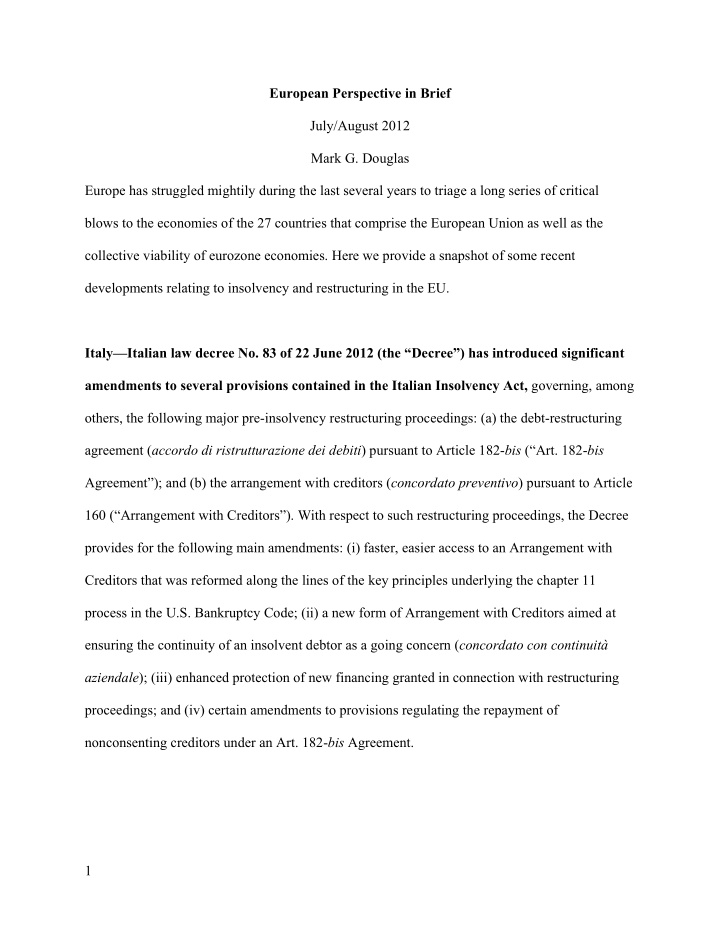



European Perspective in Brief July/August 2012 Mark G. Douglas Europe has struggled mightily during the last several years to triage a long series of critical blows to the economies of the 27 countries that comprise the European Union as well as the collective viability of eurozone economies. Here we provide a snapshot of some recent developments relating to insolvency and restructuring in the EU. Italy—Italian law decree No. 83 of 22 June 2012 (the “Decree”) has introduced significant amendments to several provisions contained in the Italian Insolvency Act, governing, among others, the following major pre-insolvency restructuring proceedings: (a) the debt-restructuring agreement ( accordo di ristrutturazione dei debiti ) pursuant to Article 182- bis (“Art. 182- bis Agreement”); and (b) the arrangement with creditors ( concordato preventivo ) pursuant to Article 160 (“Arrangement with Creditors”). With respect to such restructuring proceedings, the Decree provides for the following main amendments: (i) faster, easier access to an Arrangement with Creditors that was reformed along the lines of the key principles underlying the chapter 11 process in the U.S. Bankruptcy Code; (ii) a new form of Arrangement with Creditors aimed at ensuring the continuity of an insolvent debtor as a going concern ( concordato con continuità aziendale ); (iii) enhanced protection of new financing granted in connection with restructuring proceedings; and (iv) certain amendments to provisions regulating the repayment of nonconsenting creditors under an Art. 182- bis Agreement. 1
The UK—On 1 May 2012, the Chancery Division of the English High Court handed down its ruling in Re JT Frith Ltd (Young v Kenneth) [2012] EWHC 196 (Ch), concerning the ability of a secured lender to share indirectly in funds set aside for unsecured creditors. Section 176A (2) of the Insolvency Act 1986 provides that in cases where a floating charge has been granted over all of a company’s assets, the liquidator, administrator or receiver must make a “prescribed part” of the company’s net assets available for the benefit of unsecured creditors. A secured creditor may share in the “prescribed part” only if it: (i) releases its security; and (ii) shares as an unsecured creditor. In Frith , a junior secured creditor of a company in liquidation was held to have effectively surrendered its security interest by submitting both a deed of release and proof of debt stating that it held no security in the company. As a result, it was allowed to participate in the “prescribed part”. The significance of the case is that the junior secured creditor was also party to an intercreditor agreement with a senior secured creditor which contained a subordination clause requiring the junior lender to turn over any recoveries received from the debtor to the senior lender until the latter had been repaid in full. The result was that the senior secured lender was able to benefit indirectly from the prescribed part, even though it had already relied on its security and was therefore unable to participate in the prescribed part directly. This outcome was upheld by the court, as the intercreditor agreement was seen as a separate contractual matter between the junior and senior lenders and did not therefore undermine Section 176A (2). This case is significant. Where senior and junior creditors hold separate security, senior creditors may now require the junior creditor, as part of the turnover provisions in any intercreditor 2
agreement, to give up its security and prove as an unsecured creditor in order to allow the senior creditor to benefit indirectly from the prescribed part. It is not clear whether a court would take the same stance the Frith court did if the security were shared and the senior creditors had already made a secured recovery, or where the same entity also holds senior debt, while claiming to be unsecured vis-à-vis the junior debt. Nonetheless, we can expect to see senior creditors finding more creative ways to get money out of the prescribed-part pot. 3
Recommend
More recommend